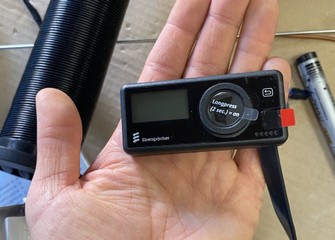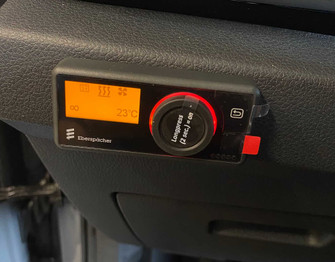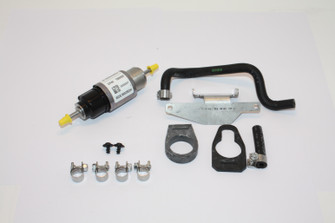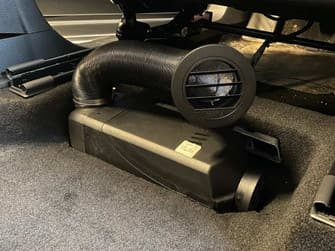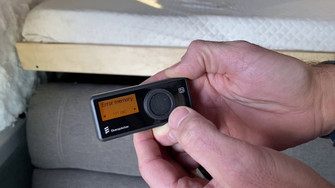How to assemble an RV water system?
Posted by Heatso on 16th Jun 2022
Having a supply of fresh water when you’re on the road is crucial. You need to consider how much water you need and be able to store and transport it...
HOW TO ASSEMBLE AN RV WATER SYSTEM?
HOW TO ASSEMBLE AN RV WATER SYSTEM?
THINGS TO CONSIDER WHEN PICKING THE BEST VAN FOR VAN LIFE
At home, fresh water is not an issue for most of us. You’re connected to the grid with enough pressure to get fresh water on tap, at any time of day. But there’s no such luxury in a motorhome.
Having a supply of fresh water when you’re on the road is crucial. You need to consider how much water you need and be able to store and transport it. Additionally, it’s worth considering how you’re going to refill, manage, and sanitize your water when needed.
In this guide, we’ll cover the basics of a camper van water system. By the end, you’ll know how to plan your water needs in advance and which van water system components are essential.
Additionally, we’ll cover getting hot water in your cabin for those nice warm showers, a luxury many vanlifers refuse to live without.
ON THIS PAGE
HOW MUCH WATER DO YOU NEED IN A CAMPERVAN?
When planning your water system, there are four fundamental points that you should consider:
Cost - Installing a water tank can be expensive, so the more water you carry, the more it will cost. In addition to the upfront cost, there are also additional expenses for filling up and fuel.
Van life - The amount of water you’ll need to carry around strongly depends on your lifestyle. If you stay at campsites with access to showers or fresh drinking water, you’ll need less than if you travel completely off-grid.
Space - Water occupies a considerable amount of space. With limited storage capacity in the van, you’ll need to be resourceful when fitting the water tanks.
Weight - At 1kg per liter, water is pretty heavy. A medium-size van has a maximum payload of 1000-1500kg, so you’ll need to account for nearly every drop of water. Also, carrying more weight significantly increases fuel consumption.
Daily water consumption of van lifers
To get an estimate of your daily consumption, consider the activities that require water. First of all, you need to stay hydrated, which is 2-3 liters per person per day, depending on the climate.
Secondly, you may want to take the occasional shower, which uses anywhere between 20 to 45 liters. Even if you adopt a “military approach” and only use water to get wet and rinse off, it’s still around 12 liters.
Finally, you need water for cooking, cleaning, and laundry. All things considered, you could use upwards of 50 liters a day.
How often will you fill-up?
Knowing how often you can fill up is important when choosing the size of your water tank. This depends primarily on where and how you’ll be traveling.
If you’ll be traveling in Europe or the US, then you’ll find that most campsites have free water. This lets you travel with a smaller water tank filling up every 3-4 days, saving space and carrying less weight.
On the other hand, you’ll need a bigger tank if you plan to avoid crowded campsites or go completely off-grid. Traveling in places like Africa, with restricted access to drinking water, will also require larger water storage.
Now you know how to calculate the right fresh water tank size. Figure out how much water you will use per day, and multiply that by how many days you’ll go between filling up. Add 10-20 liters to have some leeway, and you have your perfect tank size.
THE ESSENTIALS OF A CAMPERVAN WATER SYSTEM
A campervan or RV water system consists of only a handful of components:
- Water tanks to separately store fresh water and grey water
- Water pump to move the water around
- Accumulator tank to dampen pressure spikes
- A diesel water heater or calorifier to heat and store hot water
- Sinks, taps, and shower
These five components are enough for a home-like experience. You’ll have on-demand access to running water, hot or cold, as long as you top up the tanks. With the addition of a water filter, you can also use any lake or river as a source of drinking water.
CAMPERVAN WATER TANKS
There are 3 types of campervan water tanks you may need: freshwater tanks, greywater tanks, and blackwater tanks. Let’s take a closer look at each one.
Freshwater tank
Although something simple and affordable like a jerrycan will work perfectly, you’ll probably want a permanent freshwater tank. A full 20-liter jerrycan will weigh around 45lbs, which isn’t easy to carry around.
Once you’ve calculated how much water you need, it’s time to decide where to store it. Water tanks come in all sizes, so it’s easy to find one that fits your motorhome.
If you’re planning to travel in colder climates, we suggest you install at least one tank inside the van. Water tanks attached under or to the side of the van may freeze and even burst in sub-zero temperatures.
Filling up and preventing airlocks
You will also need a way to fill the freshwater tanks. Most camper vans and motorhomes have a water filler inlet on the outside, letting you easily top up your indoor tanks. Some vans have the same water filler inside one of the doors, closer to the water tanks.
A number of high-quality water tanks come with pre-installed tank vents. The vents allow air to fill the tanks as they are emptied. Without a vent, the air can’t escape and you’ll end up with airlocks.
Grey Water Tank
Every motorhome needs a container for collecting wastewater from the sink, indoor shower, or laundry. Again, if you’re on a tight budget, the simplest option would be to feed wastewater in a jerrycan stored under the sink.
The most comfortable option both for stealth camping and off-grid living would be a fixed grey water tank underneath the van. You can add a tap for quick and easy draining, and keep it closed the rest of the time.
The grey water tank can be much smaller than the freshwater tank, as you don’t have to wait for it to completely fill up before draining it. You can go for a container about half the size of your freshwater tank.
Black water tank
Class A and Class B RVs are the two most popular RVs among van lifers. They often come with built-in water tanks, connections to shore power, a full kitchen setup, and complete bathrooms.
Most RVs are custom made and almost nobody builds their own RV conversion, which means that they have efficient layouts and clever storage options. An RV is probably the closest you can get to a complete home on wheels, but that of course comes with a high price tag.
CAMPERVAN CASSETTE TOILETS
Thetford Porta
Potti 565E Toilet
Water pump
If you want to enjoy running water from your tap or shower, you need a water pump. An electric pump keeps your entire water cycle pressurized, so choosing the right one is important.
Pressure at the tap or shower head depends on the size of the borehole, the distance between tap and pump, as well as the power of the water pump. If you get a pump that’s too strong, you might go through your water supply too quickly. A pump that’s too weak will have trouble pushing water around.
For the majority of campervans and motorhomes, a 30PSI water pump is perfect. When choosing a pump, you want to look at the water flow it provides. Ideally, it should push roughly 10-11 liters per minute. This way, you won’t go through your entire water supply in one shower.
Water Filter
Make sure to install a small water filter to prevent debris from getting into the water pump. Debris can seriously damage the pump, so a tiny filter is definitely a worthwhile investment.
Accumulator
A SureCal accumulator tank provides 2 to 5 liters of water for use before the water pump turns on. An RV accumulator tank absorbs any sudden pressure changes with its integrated diaphragm.
It should be installed on the pressured side of your pump, for example underneath the sink. The accumulator tank will dampen water pressure 'spikes', reduce pump cycling, help increase the pump's life, and save battery power.
Surejust 2 Liter RV
Accumulator Tank
Surejust 5 Liter
Accumulator Tank
HOT WATER FOR CAMPERS AND RVS
Having an on-demand supply of hot water can be a game-changer, providing a level of comfort any home should have. After all, taking a cold shower on a cold day doesn’t sound very appealing.
Thankfully, there are several ways how you can get a reliable supply of hot water to your off-grid home. Here are the 4 most popular sources of hot water in a van life water system:
- Diesel or gasoline water heater
- Combined air and water heater
- Calorifier / Boiler
- Solar - heated water bag
Diesel or gasoline camper van water heater
Diesel camper van water heaters with a tank are a compact and reliable source of hot water. The integrated hot water tank holds the water while it is heated up and then dispensed. The water is usually fed to the heater from an adjoining cold water tank.
Some great examples of tank diesel water heaters are the Espar Hydronic S3 D5E and the Webasto Thermo Top EVO 5. Both of these have a heat output of 17,000BTU (5KW). That’s more than enough to provide a large campervan with plenty of water for a nice hot shower or washing dishes.
Combined air and water heaters
Combined water heaters have the added advantage of also warming up the air in your cabin. Camper van water heaters like the Webasto Dual Top ST 6 operate very similarly to a tank heater.
They work just like a miniature version of your van’s engine: fuel is pumped into the unit and mixed with air via an intake to create combustion. This warms up the internal heat exchanger which in turn heats the coolant. This hot liquid is run through a coil that circulates between the heater and the internal hot water tank.
In the case of combined water heaters, hot air is also passed over the heat exchanger. So while it heats up your fresh water, warmed air is also distributed in the cabin through two hot air outlets.
How to choose a Calorifier / Boiler
Calorifiers are a great option for creating hot water in your camper van as they use waste heat from your engine and require no additional resources. Most commonly used on boats, they’re also perfectly suitable for RVs and van conversions.
They work by connecting to your engine’s coolant recirculation system. Here, the heated coolant will circulate in the coils inside the calorifier’s insulated tank and heat up the water. The only downside is they are a little bulky to store, but the upside is you’ll have instant hot water as soon as you park after a day of driving.
If you’re planning on spending long periods in one spot, you can connect a diesel hot water heater to your calorifier. This will give you a complete hot water system – you’ll have a way to generate and then store lots of hot water to use on-demand, anywhere you go.
Solar-heated water bag
Black solar water bags are the manual version of hot water generation. Simply leave one out in the sun, and the heat will warm the water up inside. Although it’s only good for a quick shower, it’s a highly portable and budget-friendly option. If you’re a weekend warrior or don’t do vanlife full-time, this is a perfect hot water solution.
SETTING UP YOUR CAMPERVAN WATER SYSTEM
Having running water is a luxury we frequently take for granted. Now you know the basics of setting up your own water system, so you can live on the road in comfort. We’ve covered the most important parts of the water cycle and explained what each part does. Additionally, you now know how to reliably generate and store hot water.
SETTING UP YOUR CAMPERVAN WATER SYSTEM
Having running water is a luxury we frequently take for granted. Now you know the basics of setting up your own water system, so you can live on the road in comfort. We’ve covered the most important parts of the water cycle and explained what each part does. Additionally, you now know how to reliably generate and store hot water.

